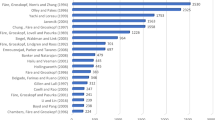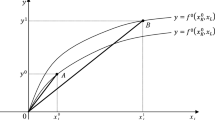Abstract
The Malmquist and Hicks-Moorsteen productivity indexes are the two most widely used theoretical indexes for measuring productivity growth. Since these productivity indexes are defined by unknown distance functions, it is necessary to estimate the distance functions to compute them in principle. On the other hand, the Törnqvist productivity index is an empirical index number formula that is directly computable from the prices and quantities of the inputs and outputs alone. Caves et al. (1982) imply that the Malmquist index coincides with the Törnqvist index under profit maximizing behaviour and constant returns to scale technology. The purpose of the present paper is to point out that the Hicks-Moorsteen productivity index coincides with the Törnqvist productivity index under the same condition. We emphasize that the condition of constant returns to scale is indispensable for deriving the equivalence between the two indexes. Moreover, even when this condition is relaxed to the α returns to scale, the equivalence between the Hicks-Moorsteen and Törnqvist productivity indexes is shown to hold true.
Similar content being viewed by others
Notes
Nishimizu and Page (1982), which adopt the deterministic frontier, is one of the earliest studies for implementing the Malmquist productivity index. Later, Färe et al. (1994) apply data envelopment analysis to specify the distance functions for implementing the Malmquist productivity index. Nemoto and Goto (2005) apply the stochastic frontier approach for implementing the Hicks-Moorsteen productivity index. Recently, Kerstens and Van De Woestyne (2014) compare two productivity indexes by applying Data Envelopment Analysis as well as Free Disposal Hull approaches.
Superlative index number formulae coincide with the theoretical indexes in more general circumstances than do other exact index number formulae. Thus, they are considered the better approximation to theoretical indexes.
This index can be considered a generalisation of the ratio of output to input growth.
Notation: y ≥ y′ indicates \({y_m} \ge {y'_m}\) for any m; y >> y′ indicates \({y_m} >{y'_m}\) for any m; y ≥ y′ indicates \({y_m} \ge {y'_m}\) for any m, but y ≠ y′; 0 M and 1 M denote M dimensional vector of zeros and ones, respectively; and \({\boldsymbol{p}} \cdot {\boldsymbol{y}} = \mathop {\sum}\nolimits_{m = 1}^M {{p_m}{y_m}}\).
The regularity conditions (P.1)-(P.7) are sufficient to ensure that the maximum in Eq. (2) and minimum in Eq. (3) exist. Färe and Primont (1995) propose alternative regularity conditions that ensure the supremum, rather than the maximum, and the infimum, rather than the minimum, in these definitions.
Strictly speaking, this is the input-oriented Malmquist productivity index. Our result is directly applicable to the output-oriented Malmquist productivity index. We focus on the former to avoid unnecessary repetition.
The cost share of the revenue from the mth output p m y m /w ⋅ x is equal to the elasticity of total cost, with respect to the individual output \(\partial \ln C\left( {{\boldsymbol{w}},{\boldsymbol{y}}} \right){\rm{/}}\partial \ln {y_m}\), under cost minimization. Thus, the productivity index T * corresponds to that adopted by Caves and Christensen (1980).
The cost minimization problem can be formulated by using the input distance function \(\mathop {{\min }}\limits_{\boldsymbol{x}} \left\{ {{{\boldsymbol{w}}^t} \cdot {\boldsymbol{x}}|{D^t}\left( {{{\boldsymbol{y}}^t},{\boldsymbol{x}}} \right) \ge 1} \right\}\) or output distance function \(\mathop {{\min }}\limits_{\boldsymbol{x}} \left\{ {{{\boldsymbol{w}}^t} \cdot {\boldsymbol{x}}|{d^t}\left( {{{\boldsymbol{y}}^t},{\boldsymbol{x}}} \right) \le 1} \right\}\). This is also true for the revenue and profit maximization problems.
All results of CCD referred to by this paper are generalised by Balk (1998), allowing for technical inefficiency. Employing Balk’s result, we can generalise this study’s result to the case when a type of technical inefficiency is allowed to exist.
The Törnqvist productivity index is far more popular than the cost-share weighted Törnqvist productivity index. Proposition 1, which is the original result of CCD, is not enough to justify the use of the Törnqvist productivity index. For this purpose, Proposition 1 needs to be reformulated as Corollary 1.
The following relationships between the input and output distance functions, such as 1 = D(y/d(y,x),x) and 1 = d(y,x/D(y,x)), exist. They are generally inconsistent with the condition that D(y,x) and d(y,x) have the translog functional form. As we explained, they are consistent under the constant returns to scale condition.
As emphasized in Footnote 8, we can reach the same conclusion from the constant returns to scale translog output distance function. Moreover, since Proposition 8 generalises Proposition 4, we omit the proof of Proposition 4.
This can be alternatively defined by a technology set, such as (y,x)∈T t implies (λ α y,λ x)∈T t for all λ 0.
A measure of local returns to scale is proposed either by using the input distance function 1/α = −y ⋅ ∇ y D(y,x)/D(y,x) or output distance function α = −x ⋅ ∇ x d(y,x)/d(y,x). This measure traces back to Panzar and Willig (1977) and Färe et al. (1986). See Balk (1998) for further explanations. Thus, while the degree of returns to scale varies depending on inputs and outputs (y,x) in general technology, it is set constant under the α returns to scale technology.
Lau (1978) and Färe and Mitchell (1993) use the term ‘homogeneous of degree α’. We follow Boussemart et al. (2009), who first call it ‘α returns to scale’ by showing that this concept could incorporate various types of returns to scale. Although attributed to Färe and Mitchell (1993), Eq. (40) is first presented in this form by Boussemart et al. (2009).
The other implication is that the derivatives of the output distance function can be expressed as those of the input distance function, and vice versa. This provides us with additional estimating equations for estimating the parameters for the translog input and output distance functions. For example, the profit maximization problem implies four sets of first-order conditions, Eqs. (22), (24), (26), and (27). While two first-order conditions, Eqs. (22) and (26), are based on the output distance function, the other first-order conditions, Eqs. (24) and (27), are based on the input distance function. Applying Eq. (49), all of these conditions can be transformed into the equations of the output distance function or those of the input distance function. Thus, if we adopt the econometric approach for implementing a theoretical productivity index, unlike in this paper, the α returns to scale is a useful specification of the underlying technology that allows us to effectively estimate the distance functions, without assuming constant returns to scale. Then, once the unknown parameters for the translog input or output distance functions have been determined, we can then determine the period t degree of returns to scale for each technology, from Eqs. (54) and (55).
We leave the extension of our results under variable degrees of scale α to future research.
First, this equation is shown by CCD.
More direct proof, which does not rely on the equivalence results derived by CCD, is provided in the Appendix.
The output distance function, which corresponds to the input distance function with the translog functional form, also has the same translog functional form.
Notation: \({\nabla _{\ln {\boldsymbol{x}}}}\ln f\left( {{\boldsymbol{y}},{\boldsymbol{x}}} \right) \equiv \left( {\frac{{\partial \ln f\left( {{\boldsymbol{y}},{\boldsymbol{x}}} \right)}}{{\partial \ln {x_1}}}, \ldots ,\frac{{\partial \ln f\left( {{\boldsymbol{y}},{\boldsymbol{x}}} \right)}}{{\partial \ln {x_N}}}} \right) = \left( {\frac{{f\left( {{\boldsymbol{y}},{\boldsymbol{x}}} \right)}}{{{x_1}}}\frac{{\partial f\left( {{\boldsymbol{y}},{\boldsymbol{x}}} \right)}}{{\partial {x_1}}}, \ldots ,\frac{{f\left( {{\boldsymbol{y}},{\boldsymbol{x}}} \right)}}{{{x_N}}}\frac{{\partial f\left( {{\boldsymbol{y}},{\boldsymbol{x}}} \right)}}{{\partial {x_N}}}} \right)\) indicates a column vector of the partial derivative of f with respect to the vector \({\boldsymbol{x}} \in {{\Bbb R}^N}\).
References
Balk BM (1998) Industrial Price, Quantity, and Productivity Indices : the Micro-Economic Theory and An Application. Kluwer Academic Publishers, Boston, MA
Bjurek H (1996) The Malmquist total factor productivity index. Scand J of Economics 98(2):303–313
Boussemart JP et al. (2009) α-Returns to scale and multi-output production technologies. Eur J Oper Res 197(1):332–339
Caves DW, Christensen LR (1980) The relative efficiency of public and private firms in a competitive environment: the case of Canadian railroads. J Pol Econ 88(5):958–976
Caves DW, Christensen LR, Diewert WE (1982) The economic theory of index numbers and the measurement of input, output, and productivity. Econometrica 50(6):1393–1414
Diewert WE (1976) Exact and superlative index numbers. J Econom 4(2):115–145
Diewert WE (1992) Fisher ideal output, input, and productivity indexes revisited. J Prod Anal 3(3):211–248
Diewert WE, Fox KJ (2010) Malmquist and Törnqvist productivity indexes: returns to scale and technical progress with imperfect competition. J Econ 101(1):73–95
Färe R et al. (1994) Productivity growth, technical progress and efficiency change in industrialized countries. Am Econ Rev 84(1):66–83
Färe R, Grosskopf S, Lovell CAK (1986) Scale Economies and Duality. J Econ 46(2):175–182
Färe R, Grosskopf S, Roos P (1996) On two definitions of productivity. Econ Lett 53(3):269–274
Färe R, Mitchell T (1993) Multiple outputs and homotheticity. South Econ J 60(2):287–296
Färe R, Primont D (1995) Multi-Output Production and Duality: Theory and Applications. Kluwer Academic Publishers, Boston, MA
Karagiannis G, Lovell CAK (2016) Productivity measurement in radial DEA models with a single constant input. Eur J Oper Res 251(1):323–328
Kerstens K, Van De Woestyne I (2014) Comparing Malmquist and Hicks-Moorsteen productivity indices: exploring the impact of unbalanced vs. balanced panel data. Eur J Oper Res 233(3):749–758
Lau LJ (1978) Application of profit functions. In: Fuss M, McFadden D eds. Production Economics: A Dual Approach to Theory and Applications Volume I: The Theory of Production. North-Holland, Amsterdam, p 133–216
Mizobuchi H (2017) Productivity indexes under hicks neutral technical change. J Prod Anal 48(1):63–68
Nemoto J, Goto M (2005) Productivity, efficiency, scale economies and technical change : a new decomposition analysis of TFP applied to the Japanese prefectures. J Jpn Int Econ 19(4):617–634
Nishimizu M, Page JM (1982) Total factor productivity growth and technological progress and technical efficiency change: dimensions of productivity change in Yugoslavia, 1965-78. Econ Jl 92(368):920–936
O’Donnell CJ (2012) An aggregate quantity framework for measuring and decomposing productivity change. J Prod Anal 38(3):255–272
Panzar JC, Willig RD (1977) Economies of scale in multi-output production. Q J Econ 91(3):481–493
Acknowledgements
I am grateful for an anonymous referee, Erwin Diewert, Bert Balk, Knox Lovell, and Chris O’Donnell for their helpful comments and suggestions. This article was completed when I visited the Centre for Efficiency and Productivity Analysis (CEPA), the School of Economics at the University of Queensland in Australia. I appreciate the adequate research environment offered by the centre and department. This research was supported by a grant for overseas research (Kokugai-kenkyu) of Ryukoku University (2015–2016), as well as Grant-in-Aid for Scientific Research (KAKENHI 25870922). All remaining errors are my responsibility.
Author information
Authors and Affiliations
Corresponding author
Ethics declarations
Conflict of interest
The authors declare that they have no competing interests.
Appendix
Appendix
Alternative Proof of Proposition 8Footnote 24
by applying Diewert (1976)’s Quadratic Identity,
by simple manipulations,
by substituting (28) into the third and the forth terms,
QED.
Rights and permissions
About this article
Cite this article
Mizobuchi, H. A superlative index number formula for the Hicks-Moorsteen productivity index. J Prod Anal 48, 167–178 (2017). https://doi.org/10.1007/s11123-017-0514-6
Published:
Issue Date:
DOI: https://doi.org/10.1007/s11123-017-0514-6




